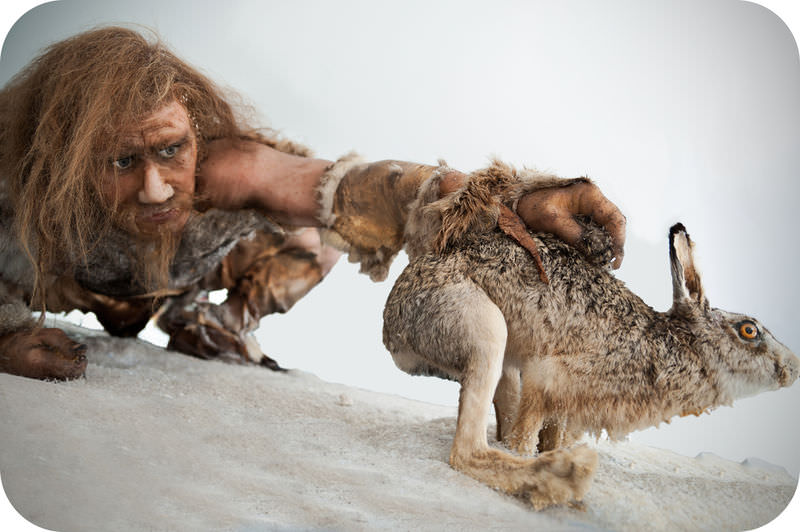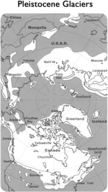12.14: Climate Change in Earth History
- Page ID
- 5541
\( \newcommand{\vecs}[1]{\overset { \scriptstyle \rightharpoonup} {\mathbf{#1}} } \)
\( \newcommand{\vecd}[1]{\overset{-\!-\!\rightharpoonup}{\vphantom{a}\smash {#1}}} \)
\( \newcommand{\id}{\mathrm{id}}\) \( \newcommand{\Span}{\mathrm{span}}\)
( \newcommand{\kernel}{\mathrm{null}\,}\) \( \newcommand{\range}{\mathrm{range}\,}\)
\( \newcommand{\RealPart}{\mathrm{Re}}\) \( \newcommand{\ImaginaryPart}{\mathrm{Im}}\)
\( \newcommand{\Argument}{\mathrm{Arg}}\) \( \newcommand{\norm}[1]{\| #1 \|}\)
\( \newcommand{\inner}[2]{\langle #1, #2 \rangle}\)
\( \newcommand{\Span}{\mathrm{span}}\)
\( \newcommand{\id}{\mathrm{id}}\)
\( \newcommand{\Span}{\mathrm{span}}\)
\( \newcommand{\kernel}{\mathrm{null}\,}\)
\( \newcommand{\range}{\mathrm{range}\,}\)
\( \newcommand{\RealPart}{\mathrm{Re}}\)
\( \newcommand{\ImaginaryPart}{\mathrm{Im}}\)
\( \newcommand{\Argument}{\mathrm{Arg}}\)
\( \newcommand{\norm}[1]{\| #1 \|}\)
\( \newcommand{\inner}[2]{\langle #1, #2 \rangle}\)
\( \newcommand{\Span}{\mathrm{span}}\) \( \newcommand{\AA}{\unicode[.8,0]{x212B}}\)
\( \newcommand{\vectorA}[1]{\vec{#1}} % arrow\)
\( \newcommand{\vectorAt}[1]{\vec{\text{#1}}} % arrow\)
\( \newcommand{\vectorB}[1]{\overset { \scriptstyle \rightharpoonup} {\mathbf{#1}} } \)
\( \newcommand{\vectorC}[1]{\textbf{#1}} \)
\( \newcommand{\vectorD}[1]{\overrightarrow{#1}} \)
\( \newcommand{\vectorDt}[1]{\overrightarrow{\text{#1}}} \)
\( \newcommand{\vectE}[1]{\overset{-\!-\!\rightharpoonup}{\vphantom{a}\smash{\mathbf {#1}}}} \)
\( \newcommand{\vecs}[1]{\overset { \scriptstyle \rightharpoonup} {\mathbf{#1}} } \)
\( \newcommand{\vecd}[1]{\overset{-\!-\!\rightharpoonup}{\vphantom{a}\smash {#1}}} \)
\(\newcommand{\avec}{\mathbf a}\) \(\newcommand{\bvec}{\mathbf b}\) \(\newcommand{\cvec}{\mathbf c}\) \(\newcommand{\dvec}{\mathbf d}\) \(\newcommand{\dtil}{\widetilde{\mathbf d}}\) \(\newcommand{\evec}{\mathbf e}\) \(\newcommand{\fvec}{\mathbf f}\) \(\newcommand{\nvec}{\mathbf n}\) \(\newcommand{\pvec}{\mathbf p}\) \(\newcommand{\qvec}{\mathbf q}\) \(\newcommand{\svec}{\mathbf s}\) \(\newcommand{\tvec}{\mathbf t}\) \(\newcommand{\uvec}{\mathbf u}\) \(\newcommand{\vvec}{\mathbf v}\) \(\newcommand{\wvec}{\mathbf w}\) \(\newcommand{\xvec}{\mathbf x}\) \(\newcommand{\yvec}{\mathbf y}\) \(\newcommand{\zvec}{\mathbf z}\) \(\newcommand{\rvec}{\mathbf r}\) \(\newcommand{\mvec}{\mathbf m}\) \(\newcommand{\zerovec}{\mathbf 0}\) \(\newcommand{\onevec}{\mathbf 1}\) \(\newcommand{\real}{\mathbb R}\) \(\newcommand{\twovec}[2]{\left[\begin{array}{r}#1 \\ #2 \end{array}\right]}\) \(\newcommand{\ctwovec}[2]{\left[\begin{array}{c}#1 \\ #2 \end{array}\right]}\) \(\newcommand{\threevec}[3]{\left[\begin{array}{r}#1 \\ #2 \\ #3 \end{array}\right]}\) \(\newcommand{\cthreevec}[3]{\left[\begin{array}{c}#1 \\ #2 \\ #3 \end{array}\right]}\) \(\newcommand{\fourvec}[4]{\left[\begin{array}{r}#1 \\ #2 \\ #3 \\ #4 \end{array}\right]}\) \(\newcommand{\cfourvec}[4]{\left[\begin{array}{c}#1 \\ #2 \\ #3 \\ #4 \end{array}\right]}\) \(\newcommand{\fivevec}[5]{\left[\begin{array}{r}#1 \\ #2 \\ #3 \\ #4 \\ #5 \\ \end{array}\right]}\) \(\newcommand{\cfivevec}[5]{\left[\begin{array}{c}#1 \\ #2 \\ #3 \\ #4 \\ #5 \\ \end{array}\right]}\) \(\newcommand{\mattwo}[4]{\left[\begin{array}{rr}#1 \amp #2 \\ #3 \amp #4 \\ \end{array}\right]}\) \(\newcommand{\laspan}[1]{\text{Span}\{#1\}}\) \(\newcommand{\bcal}{\cal B}\) \(\newcommand{\ccal}{\cal C}\) \(\newcommand{\scal}{\cal S}\) \(\newcommand{\wcal}{\cal W}\) \(\newcommand{\ecal}{\cal E}\) \(\newcommand{\coords}[2]{\left\{#1\right\}_{#2}}\) \(\newcommand{\gray}[1]{\color{gray}{#1}}\) \(\newcommand{\lgray}[1]{\color{lightgray}{#1}}\) \(\newcommand{\rank}{\operatorname{rank}}\) \(\newcommand{\row}{\text{Row}}\) \(\newcommand{\col}{\text{Col}}\) \(\renewcommand{\row}{\text{Row}}\) \(\newcommand{\nul}{\text{Nul}}\) \(\newcommand{\var}{\text{Var}}\) \(\newcommand{\corr}{\text{corr}}\) \(\newcommand{\len}[1]{\left|#1\right|}\) \(\newcommand{\bbar}{\overline{\bvec}}\) \(\newcommand{\bhat}{\widehat{\bvec}}\) \(\newcommand{\bperp}{\bvec^\perp}\) \(\newcommand{\xhat}{\widehat{\xvec}}\) \(\newcommand{\vhat}{\widehat{\vvec}}\) \(\newcommand{\uhat}{\widehat{\uvec}}\) \(\newcommand{\what}{\widehat{\wvec}}\) \(\newcommand{\Sighat}{\widehat{\Sigma}}\) \(\newcommand{\lt}{<}\) \(\newcommand{\gt}{>}\) \(\newcommand{\amp}{&}\) \(\definecolor{fillinmathshade}{gray}{0.9}\)How important was the Pleistocene ice age to human evolution?
Climate is dynamic; climate has changed through Earth's history. Climate has changed a lot during the time humans have been evolving. As the climate got colder, people learned to hunt more since plants became scarce in the winter. Better hunting required better tools. Better tools helped to spur on the evolution of culture.
How Earth’s Climate Changes
Earth’s climate has changed many times through Earth's history. Over much of Earth’s past, the climate was warmer than it is today. Picture in your mind dinosaurs roaming the land. They're probably doing it in a pretty warm climate (Figure below)!
Dinosaurs thrived during one of the warmest periods in Earth's history.
But ice ages also occurred many times in the past. An ice age is a period when temperatures are cooler than normal. This causes glaciers to spread to lower latitudes. Scientists think that ice ages occurred at least six times over the last billion years alone. How do scientists learn about Earth’s past climates?
The last major ice age took place in the Pleistocene. This epoch lasted from 2 million to 14,000 years ago. Earth’s temperature was only 5° C (9° F) cooler than it is today. But glaciers covered much of the Northern Hemisphere. Below, you can see how far south they went (Figure below). Clearly, a small change in temperature can have a big impact on the planet. Humans lived during this ice age.
Pleistocene glaciers covered an enormous land area. Chicago is just one city that couldn't have existed during the Pleistocene.
Why Climate Changes
Several natural processes may affect Earth’s temperature. They range from sunspots to Earth’s wobble.
- Sunspots are storms on the Sun. When the number of sunspots is high, the Sun gives off more energy than usual. Still, there is little evidence for climate changing along with the sunspot cycle.
- Plate movements cause continents to drift closer to the poles or the Equator. Ocean currents also shift when continents drift. All these changes can affect Earth’s temperature.
- Plate movements trigger volcanoes. A huge eruption could spew so much gas and ash into the air that little sunlight wouldn't reach the surface for months or years. This could lower Earth’s temperature.
- A large asteroid hitting Earth would throw a lot of dust into the air. This could block sunlight and cool the planet.
- Earth goes through regular changes in its position relative to the Sun. Its orbit changes slightly. Earth also wobbles on its axis of rotation. The planet also changes its axial tilt, the angle of its axis of rotation. These changes can affect Earth’s temperature.
Summary
- Earth's climate has been warmer and colder, but mostly warmer, through Earth history.
- Many natural processes change Earth's climate. These include sunspots, plate tectonics, volcanism, asteroid impacts, and Earth's motions.
- The Pleistocene Ice Age lasted from 2 million to 14,000 years ago. Earth’s temperature was only 5° C (9° F) cooler than it is today.
Review
- How has climate changed in the past 14,000 years?
- How can the Sun change Earth's climate?
- What is an ice age? When was the most recent?
Explore More
Use the resource below to answer the questions that follow.
This video deals with the time period at the end of the Paleozoic, called the Permian, 250,000,000 years ago. At that time there was a great mass extinction. Since it was so long ago, scientists must use many types of evidence to determine its cause.
- What were therapsids? What was their great accomplishment?
- What occurred 250 million years ago?
- What natural disaster occurred at around the same time?
- How much warming did Peter Ward calculate could have happened as a result of this natural disaster? What evidence did he use for his calculation?
- Did this explain the mass extinction at the end of the Permian? Why or why not?
- What happened during the first phase of the extinction?
- What happened during the second phase of the extinction?
- What happened during the third phase of the extinction?
- What increased between the marine extinction and the final land extinction? What caused this?
- In all, what caused the Earth's temperature to rise by 10 degrees?
- How long did it take for life to recover? What animals came to dominate the Earth?




